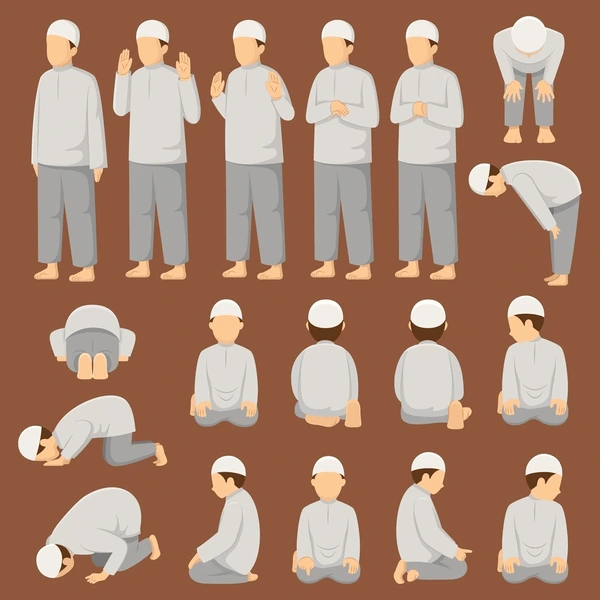Praying Salat, or Namaz, is a compulsory part of a Muslim’s daily routine, connecting the believer with Allah Almighty. Among the five daily prayers, Maghrib Prayer Salat/ Namaz is performed just after sunset. It consists of Fardh three rakats.
If you’re new to Magrib Salah, this guide will help you understand how to pray Maghrib Salat step by step.
Let’s dive into the details.

Learn Quran Kareem and Islamic studies with expert male and female Quran tutors. Enroll now!
The Importance of Maghrib Prayer in Islam
Maghrib prayer holds a special significance as it symbolizes the completion of the day and the transition to evening. It’s a reminder for Muslims to be thankful for the blessings of the day and to seek forgiveness for any shortcomings. Performing Maghrib Salah consistently is a way to maintain a strong spiritual connection with Allah (SWT).
Timing of Maghrib Salat
How to Determine Maghrib Time
Maghrib time begins just after sunset when the sun disappears below the horizon. You can use a local prayer timetable or mobile app to find the exact time in your area.
The Duration of Maghrib Time
The time for Maghrib lasts until the twilight disappears from the sky, which is usually about an hour to an hour and a half after sunset. It’s best to pray as soon as possible after sunset to fulfill the obligation within its preferred time.
The Number of Rak’ats in Maghrib Namaz
Explanation of Rak’at
A Rak’at is a unit of Islamic prayer, consisting of specific actions and recitations. Each Rak’at includes standing, bowing, and prostrating.
Obligatory and Sunnah Rak’ats in Maghrib
Maghrib prayer consists of three obligatory Rak’ats, followed by two Sunnah Rak’ats that are recommended but not mandatory. Praying the Sunnah after the obligatory prayer adds to the spiritual rewards and helps perfect one’s Salat. This namaz also has two non-obligatory nafls.
Preparing for Maghrib Salah
Performing Wudu (Ablution)
Before starting the prayer, performing Wudu (ablution) is essential to ensure cleanliness. Wash your hands, mouth, nose, face, arms, head, ears, and feet in that order, as prescribed.

Choosing a Clean Place to Pray
Make sure the place where you pray is clean, free from impurities, and suitable for worship. A prayer mat can be used to ensure the cleanliness of the prayer space.
How to Make the Intention (Niyyah) for Maghrib Salah
Making the intention, or Niyyah, is an important step before starting the prayer. The intention should be made in your heart, expressing your desire to pray three Rak’ahs of Maghrib Salat for the sake of Allah Almighty.
Achieve your goal of memorizing the Quran with structured lessons and personalized support. Begin your Quran memorization course with a 5 day free trial!
Step-by-Step Guide for Maghrib Prayer
Step 1: Make your Intention (Niyyah)
Begin by silently making an intention in your heart to offer Maghrib prayer for the sake of Allah (SWT). Your entire focus should be solely on your connection with Allah during this sacred moment.
Step 2: Raise Your Hands and Say “Allahu Akbar”
Raise your hands to your ears and say “Allahu Akbar” (Allah is Greater), signaling the beginning of your prayer. This powerful phrase reminds you that Allah is greater than anything in your life at that moment.
Step 3: Place Your Hands Over Your Naval
Lower your hands and place your right hand over your left, just above your navel. This is a symbol of humility before Allah.
Step 4: Focus Your Eyes on the Place of Prostration
Keep your eyes focused on the spot where your forehead will touch the ground during sujud. Prophet Muhammad (peace be upon him) recommended this as a way to maintain focus during prayer.
Step 5: Recite the Opening Dua (Optional but Recommended)
After saying “Allahu Akbar,” you may recite the following supplication:
Subhanakal-lahumma wabihamdika
Watabarakas-muka
Wataa ‘ala jadduka
Wala ilaha ghayruka.
“How perfect You are, O Allah, and I praise You. Blessed is Your Name, exalted is Your majesty, and there is none worthy of worship besides You.”
Step 6: Recite Surah Al-Fatiha
Next, recite the opening chapter of the Qur’an, Surah Al-Fatiha:
A’auodu billaahi minash-shaytaanir rajeem
“I seek refuge in Allah from the accursed Shaytan.”
Bismillaahir Rahmaanir Raheem
In the name of Allah, the Most Gracious, the Most Merciful.
Al hamdu lillaahi rabbil ‘aalameen
Praise be to Allah, Lord of all the worlds.
Ar-Rahmaanir Raheem
The Most Gracious, the Most Merciful.
Maaliki yawmid deen
Master of the Day of Judgement.
Iyyaaka na’budu wa iyyaaka nasta’een
You alone we worship, and You alone we ask for help.
Ihdinas siraatal mustaqeem
Guide us on the straight path,
Siraatal ladheena an’amta ‘alayhim
Ghayril maghdoobi ‘alayhim waladdaalleen.
The path of those whom You have favored, not of those who have evoked [Your] anger or of those who are astray.
Learn to recite the Quran with proper Tajweed and deepen your connection with the divine. Enroll to get one week free trial in our comprehensive Quran recitation course!
Step 7: Recite Another Chapter (Optional)
After Surah Al-Fatiha, you can recite a short chapter from the Qur’an, such as Surah Al-Ikhlas, though it’s optional.
Step 8: Bow Down into Ruku
Say “Allahu Akbar” and bow down, placing your hands on your knees and keeping your back straight. In this position, recite three times:
Subhanna rabbi al-‘adheem
“How perfect is my Lord, the Magnificent.”
Step 9: Return to Standing (Qiyam)
As you rise from ruku, say:
Samee Allahu liman hamidah
“Allah hears those who praise Him.”
Then, once upright, say:
Rabbana walakal hamd
“Our Lord, to You belongs all praise.”
Step 10: Prostrate in Sujud
Say “Allahu Akbar” and move into prostration, making sure that your forehead, nose, palms, knees, and toes are all touching the ground. While in this position, recite three times:
Subhanna rabbi al-‘alaa
“How perfect is my Lord, the Most High.”
Step 11: Sit Between the Two Sujud
After the first sujud, rise and sit on your left leg, with your right foot upright. Place your hands on your knees and say:
Rabbigh-firlee
“O my Lord, forgive me.”
Step 12: Perform a Second Sujud
Repeat sujud once more, saying again:
Subhanna rabbi al-‘alaa
“How perfect is my Lord, the Most High.”
Step 13: Stand for the Second Rakah
After completing the second sujud, say “Allahu Akbar” and rise to stand for the second rakah. Repeat steps 5 through 12.
Step 14: Perform Tashahhud at the End of Two Rakats
After completing the two sujud of the second rakah, sit and recite the tashahhud:
At-tahiyyatu lilaahi was-salawaatu wat-tayyibaatu.
Assalamu ‘alayka ayyuhan-nabiyyu wa rahmatu Allah wa barakatuh.
Assalamu ‘alayna wa ‘ala ‘ibaadillahis-saaliheen.
Ash-hadu alla ilaha illa Allah, wa ash-hadu anna Muhammadan abduhu wa rasooluh.
“All the compliments are for Allah and all the prayers and all the good things (are for Allah). Peace be on you, O Prophet, and Allah’s mercy and blessings (are on you). And peace be on us and on the good (pious) worshipers of Allah. I testify that none has the right to be worshipped but Allah and that Muhammad is His slave and Apostle.”
When reciting “wa ashhadu anna Muhammadan abduhu wa rasuluh,” it is a Sunnah practice to raise the index finger or forefinger. Additionally, it is recommended to recite the Tashahhud quietly.
Then, proceed to the third rak’at to complete the Maghrib prayer.
Step 15: Add Final Tashahhud and Durood in the Third Rakat
In the final rakat, after the tashahhud, add this durood:
Allahumma salli ‘ala Muhammadin wa ‘ala aali Muhammad
Kamaa salayta ‘ala Ibraaheem wa ‘ala aali Ibraaheem
Innaka Hameedun Majeed.
Wa baarik ‘ala Muhammadin wa ‘ala aali Muhammad
Kamaa baarakta ‘ala Ibraaheem wa ‘ala aali Ibraaheem
Innaka Hameedun Majeed.
“O Allah, send prayers upon Muhammad and upon the family of Muhammad, just as You sent prayers upon Ibrahim and the family of Ibrahim. Verily, You are Praiseworthy, Glorious. O Allah, bless Muhammad and the family of Muhammad as You blessed Ibrahim and the family of Ibrahim. Verily, You are Praiseworthy, Glorious.”
Step 16: Conclude the Prayer with Tasleem
Finally, to end your prayer, turn your head to the right and say:
Assalamu alaykum wa rahmatu Allah
Then, turn your head to the left and say the same.
With this, your Fardh Maghrib prayer is complete!
Conclusion of Maghrib Prayer
Praying Maghrib Salah/ Namaz is a beautiful way to end your day in devotion and reflection. It serves as a spiritual anchor that brings Muslims closer to Allah (SWT), offering both peace and rewards. Following this guide will help beginners confidently perform Maghrib and establish a consistent prayer routine.
Strengthen your daily prayers by learning and perfecting key surahs of the Quran-e-Kareem. Sign up today!


